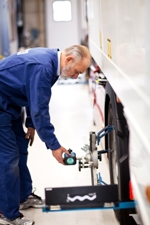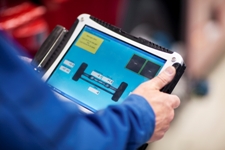According to Volvo, rectifying faults can significantly reduce carbon emissions.
 According to Volvo, two-thirds of Europe’s truck rigs are driving around with incorrect wheel alignment, many also have the wrong tyre type and the wrong tyre pressure. Carbon dioxide emissions from these rigs would be able to be significantly reduced if these faults were rectified – in some cases by as much as 15%. These findings were revealed in a large-scale test that tyre manufacturer Michelin carried out in partnership with Volvo Trucks.
According to Volvo, two-thirds of Europe’s truck rigs are driving around with incorrect wheel alignment, many also have the wrong tyre type and the wrong tyre pressure. Carbon dioxide emissions from these rigs would be able to be significantly reduced if these faults were rectified – in some cases by as much as 15%. These findings were revealed in a large-scale test that tyre manufacturer Michelin carried out in partnership with Volvo Trucks.
"We know that wheel alignment, tyre type and tyre pressure all have a major impact on fuel consumption," said Arne-Helge Andreassen, Business Area Manager for tyres and wheel alignment at Volvo Trucks' Aftermarket department.
Since fuel consumption is directly linked to carbon dioxide emissions, Volvo Trucks and tyre manufacture Michelin decided to produce statistical data on just how much wheel alignment, tyre pressure and rolling resistance affect fuel consumption and thus carbon dioxide emissions. In a two-week long test, a rig with optimal tyres, tyre pressures and wheel alignment was compared with a vehicle featuring different wheel alignments and tyre parameters.
Analysis of the test results revealed that there can be a difference of as much as 14.5% in fuel consumption depending on how the wheels are aligned and equipped. Choice of tyre can cut consumption by as much as 11%, correct tyre inflation brings a reduction of 1%, while proper wheel alignment can cut fuel consumption by 2.5%.
"There is a lack of awareness in the transport industry about the importance of checking tyres and wheel alignment, on both the truck and the trailer," said Arne-Helge Andreassen. "At our dealers, we can help haulage companies check the entire rig and correct any problems. If everyone did this, it would have a significant impact on carbon dioxide emissions."
Commercial traffic accounts for 30-40% of total carbon dioxide emissions from road transport. "As a manufacturer of heavy vehicles we have considerable responsibility. We must try to do everything we can to reduce emissions of carbon dioxide," Arne-Helge Andreassen continued. "It's not enough to just build fuel-efficient engines, Volvo Trucks works consistently and in a variety of ways to cut the fuel consumption of our vehicles throughout their lifecycle."
Here's how the test was carried out:
Mats Lidbeck from SP (the Technical Research Institute of Sweden) was on location both at the test track and in the workshop when the tests were carried out.
"We serve as a guaranteed neutral third party and we reviewed the measurement methods, ensuring that the engineers had taken into account all the most important aspects. For example, that the measuring instruments were suited to the task and were correctly calibrated, and that the proper testing procedures were followed," he explained.
The tests used two Volvo FH 4x2 trucks, each equipped with a 500 hp 13-litre Euro 5 engine, and each hauling a fully loaded van-bodied trailer. The rigs each weighed 40 tonnes gross. One rig was driven with a variety of incorrect wheel alignment settings.
"All the conditions tested were realistic, no exaggerations were allowed. Real life is bad enough. Diesel consumption increases dramatically if the wheels are not entirely parallel, and this applies to all vehicles, for construction and long-haul operations too. A trailer with a rear axle angled to the right will roll diagonally across the road and its side panels will operate as a sail that traps the wind," explained Arne-Helge Andreassen.
The rig was also run with various tyres and various tyre pressures.
"One-third of fuel consumption stems from the tyres' rolling resistance. Having the right tyres is of paramount importance. And checking tyre pressure - which has a significant effect on fuel consumption - is also important," said Jacques de Giancomoni, Technical Account Manager at Michelin.
The second rig served as a reference vehicle and was consistently run with optimally aligned wheels and with standard tractor and trailer tyres from Michelin.
The trucks were not only equipped with fuel gauges but also with special instruments that monitored exact speed, tyre wear, tyre pressure, rolling resistance and so on. Prior to each test cycle the two rigs were first driven for one hour on the track to warm up the engine, transmission and rear axles in order for the tests to be as reliable as possible. The test engineers made adjustments in the test results for factors such as wind, rain and temperature. The tests took two weeks to complete and the total mileage for the test cycles was just over 1000 kilometres.


Top: The two rigs on the test track at SP - Sweden's Technical Research Institute
Left: Adjusting tyres; Right: Statistical data